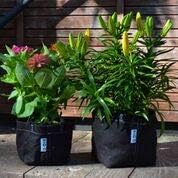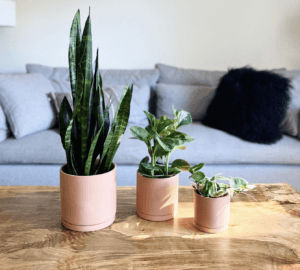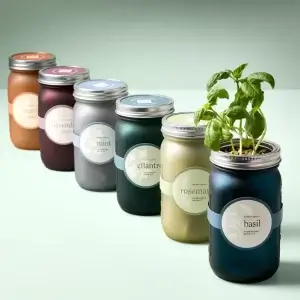Container Gardening
While summer is in full swing, it’s never too late to start planning ahead for the next growing season! With farmers markets and locally grown produce gaining popularity, the benefits of growing your own food are endless. For those that don’t have a big yard or rent, container gardening is a way to grow produce at home in a compact space!
Organic vs. Conventionally Grown
As a toxins coach, the importance of organic produce is paramount to your health!! Toxic pesticides and herbicides can really impact you from destroying your gut microbiome to increasing your risk for chronic diseases.
Take a look at this year’s Dirty Dozen and Clean Fifteen, which are published every year by the Environmental Working Group. The types of conventionally grown produce on the Dirty Dozen list are more likely to contain higher amounts of toxic pesticides, and the foods on the Clean Fifteen list are less likely to have high amounts of pesticides.
If you’ve been reading the news, a major herbicide (weedkiller) that’s been in the headlines several times in the last several years is glyphosate. Many multi-million dollar lawsuits have been filed against Monsanto/Bayer for the extensive damage to human health as well as our environment. Many crops have also been genetically modified to be “RoundUp Ready” which impacts not just our food, but our food’s food! “You are what your food ate!”
Barriers to Eating an Organic Diet
Eating organic food can greatly reduce the amount of exposure to these toxic chemicals, but there are some barriers to this – mainly cost and availability. Enter – container gardening!! In this article, we will discuss the pros and cons of container gardening and some options for nontoxic containers.
Container Gardening – Pros & Cons
Growing produce at home can help lower the cost of buying expensive produce at the store as well as having them readily available. Container gardening is convenient for renters and those who often relocate for work. It also allows you to have a more controlled environment, rotating locations outside with the sun as the seasons change, as well as the ability to move indoors or out with extreme weather.
Remember to take into account that container gardening is a confined space. The plants are limited to the size of the container they’re planted in so factor in the size the plant is expected to grow to avoid root confinement. Some plants also consume nutrients more readily from the soil so you may need to change out the soil annually. Ensuring adequate drainage of the plant and appropriate watering will also make for happy plants.
Gardening Basics
Other factors of gardening whether in a container or in-ground, include quality soil, water, and non-GMO heirloom seeds. For soil, try finding an organic or quality soil at your local garden center or hardware store like this, this, this, or this. For water, there is tap water, hose water (city or well), and rainwater. We often have to weigh the pros and cons of various options as there is no “perfect solution.” That being said, indoor plants can be watered with your filtered drinking water. If outside, well water can be tested for toxins and you can invest in a hose filter or better hose (filter, filter, hose, hose). Rainwater can also be collected systematically (rainwater barrel) and reused for the garden. With that in mind — remember that toxins are ubiquitous! It is reality that they are present everywhere in our environment and so, everything will be exposed to some level of toxins. Albeit less in your yard than if they’re sprayed multiple times on a conventional mass-production farm. Lastly, non-GMO heirloom seeds!! There are several good resources for both seeds and plants: https://www.southernexposure.com/, https://www.rareseeds.com/, https://www.seedsavers.org/, https://seedsforgenerations.com, https://migardener.com/ .
Remember that certain plants grow better in certain climates. You can look up your growing zone here to see if the plants you want to grow are suitable for your area. Here is more information about learning how to garden.
Okay, so let’s dive into the containers!! These are categorized into containers that can be used outside, inside or outside, and strictly inside.
Nontoxic Container Gardening
OUTSIDE
Grow Bags: Synthetic vs Natural
Grow bags are a popular option for gardeners as they are flexible and lightweight. A lot of grow bags are made of synthetic materials to help avoid rapid decomposition from the elements, but keep in mind the heat from the sun will transfer some of the toxins into the soil. The leaching is similar to microwaving plastic (this is why standard plastic pots are not included in this guide). But the benefits of growing organic produce at home still weigh heavy!
Synthetic

Here are grow pots made with a plant-based fabric that claims to be 100% biodegradable and compostable: Bio-D Grow Pots.
 Synthetics can often be made with recycled materials. Here is one made with recycled water bottles: Root Pouch Fabric Pot.
Synthetics can often be made with recycled materials. Here is one made with recycled water bottles: Root Pouch Fabric Pot.

These following options are kits with grow pots made from polyester: Self-Watering Fabric Garden Pot & Fabric Garden Pot Kit.
Natural

Natural grow bags can be made with burlap bags made from jute plants. While the material is totally natural, keep in mind many burlap bags can be treated with chemicals to extend their life. This specific product from Sandbaggy has not been treated with any chemicals which is great for organic gardening, but the material can also easily biodegrade. This means the bag may need to be replaced seasonally. The woven fabric also allows the roots to have freedom and flexibility rather than hitting the walls of a rigid pot.
Metal Tubs
Another outdoor option that will last longer in the elements are steel tubs. These usually require drilling some holes in the bottom to ensure adequate drainage. Hot dipped or galvanized steel refers to the process the steel has gone through to prevent rusting. The concern with this option is that it can leach metals into soil with extreme heat, acidity, or gradually over time. Here is a tutorial.

There are various sizes and depths but remember that soil gets heavy so it may get harder to move the bigger it gets. If you’re planning on keeping it in one spot, bring it on! Behrens is a popular brand of galvanized steel tubs that is also Prop 65 compliant.

Another option is this steel bed that is both elevated and on wheels: Elevated Rolling Garden Bed. The company says the material of the tub is aluzinc steel with an award-winning paint that is anti-corrosive and does not leach chemicals into the soil.
INSIDE/OUTSIDE
Wooden Planters
Wooden planters are a beautiful way to display your plants. Keep in mind that wood will not last forever in the elements and will eventually need to be replaced due to damage from the sun and moisture. That being said, cedar is a hardier species of wood that tends to be more weather-resistant.

Here is a planter box made from cedar sealed with a silica stabilizer: Earth Easy Cedar Planter Box and one that is elevated: Elevated Cedar Planter.

This planter uses FSC (Forest Stewardship Council) certified wood and a food-safe finish (unsure of more details on this):VegTrug Planter.

This planter uses Western Red Cedar (also FSC certified) that contains only naturally-occurring preservatives – no added chemicals (!) and galvanized steel legs: Elevated Planter – Steel Legs.

Here is a more affordable option made from fir grown in China similar to yellow pine. The wood comes unfinished and should be treated before being used (a nontoxic option is linseed oil): Boldly Growing Cedar Raised Planter Box.
Here is another option also made from fir wood in China. The wood should also be treated before being used: Best Choice Products 48x24x30in Raised Garden Bed.
Terracotta Pots
Terra cotta pots have been used for centuries around the world, now made in Italy, China, and Mexico. They are beautiful earthenware, totally nontoxic, and made from natural materials. The clay material is porous allowing plants to breathe and moisture to be regulated – meaning, you may also have to water more frequently in a hot climate. The one major downfall with terra cotta pots is their fragility. They can easily crack and/or break by accident as well as if they’re left in freezing conditions where the ice can crack the pot. Since these pots are so fragile but also readily available, it’s recommended to find some locally to inspect for cracks.

Here are some online options to get you started: Belle Decor on Etsy, Arizona Pottery, and at your local Home Depot.
Hydroponic
Hydroponic gardening does not use soil – only water!

This is a hydroponic kit that makes the most out of limited space and has both indoor and outdoor options. This is a vertical stand that can be customized to add more space for more plants. The company ships the stand for free (made from ocean-bound BPA-free plastic – this does not mean it is free from bisphenols) and you get to pick out a pack of seedlings (using non-GMO, sometimes organic seeds): The Farmstand.
INSIDE
Some planters and pots are meant for indoor use and not weather-resistant. This includes glass which is an inert material and does not leach chemicals into the soil. As mentioned previously, there needs to be a drainage method for excess water to escape.
Glass Pots

This particular product utilizes the porosity of terra cotta combined with glass to create a self-watering mechanism: Terra Cotta Glass Pot.

This product is made of entirely borosilicate glass so you can visualize the root system. Don’t put this in a windowsill or algae can grow: Sheer Glass Pot (Etsy).
Mason Jars

This product uses a painted mason jar which is both pretty and protects against algae growth so feel free to put this beauty on your windowsill!! This is also hydroponic meaning there is no soil. Plus, it has the option of picking what herb seeds you want and includes the supplies needed for the hydroponic set up: Garden Jar.

This link is not a product, but a DIY tutorial! Mason jars are used for a variety of purposes and now that can include gardening! This tutorial uses a few easily found supplies to create a mini herb garden of your choosing: Mason Jar Tutorial.
Nontoxic Container Gardening
So who’s ready to start growing?! Learning to grow your own produce is a valuable skill to becoming self-sustainable. Plus, there are the benefits of the freshest fruits, veggies, and herbs at your fingertips! There is definitely some sweat equity involved and learning curves to growing your own food. However, if you’re ready to take on the challenge of growing organic food- you can do it! Don’t forget to start small to make sure you have enough time to tend to all your new plants. Here’s to container gardening and green thumbs!
Find the article at The Filtery here!
